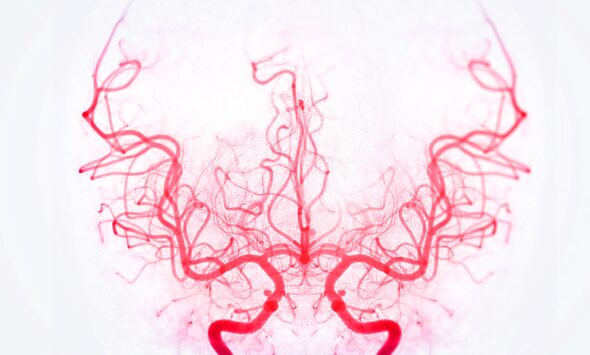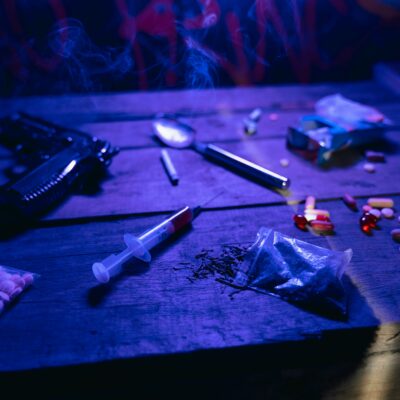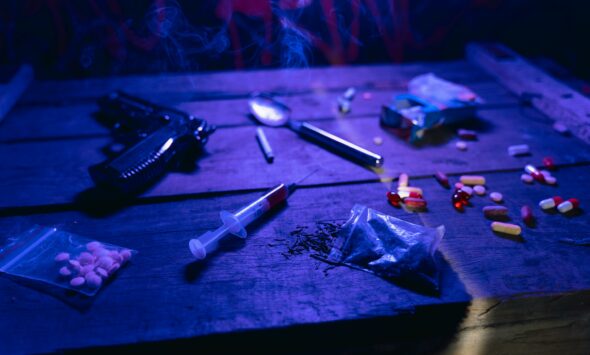Dead bodies are a highly contested resource: some insects do not hesitate to travel kilometers to lay their eggs there. This necrophagous entomofauna is usually discreet but omnipresent: the slightest dead animal is immediately colonized. Even though human bodies are rare compared to other animals, they do not escape this fatal attraction.
As soon as death occurs, a body attracts new occupants: if the weather is good, flies arrive in just a few minutes. They lay hundreds of eggs, which hatch into just as many maggots. Under the effect of this rapid and massive colonization, the corpse becomes a true ecosystem. Forensic entomology analyzes the insects within this ecosystem in order to estimate the time and sometimes the circumstances of death. This type of expertise has deep roots (the first written records date back to the 13th century), but the methods have evolved considerably in recent years. At the end of the 19th century, a French veterinarian, J.P. Mégnin, proposed a chronology based on the succession of insects. This principle, known as the “theory of squads of carrion insects”, long served as a reference for dating corpses. It was gradually abandoned, however, because of its lack of precision and reliability. The squad method is therefore no longer used for judicial dating, which now relies instead on calculating the age of larvae.
Which insects colonize a corpse?
The most common and abundant species are flies from the family Calliphoridae. Females can detect a body from kilometers away and even enter houses. Each female lays a cluster of about 200 eggs, which hatch into small maggots. Despite their small size, these eggs and young larvae are relatively easy to spot: they are generally found around the face (eyes, nostrils, eyebrows), the scalp, at the interface with the ground, or in moist and protected areas (clothing). These blowfly larvae feed on the flesh for several days, then move away from the corpse to find a shelter where they transform into pupae (cocoons) inside which they metamorphose into adult flies. In addition to Calliphoridae, flies from the families Muscidae, Faniidae and Sarcophagidae also colonize corpses, though at a later stage. Their biology allows them to develop and reproduce on the same corpse for several generations. Some species can even penetrate confined spaces such as coffins, where they are observed in abundance during exhumations.
Throughout decomposition, beetles from the families Necrophoridae, Histeridae and Staphylinidae may also be found. Apart from some common species such as Necrodes littoralis or Creophilus maxilosus, these insects are relatively poorly understood and therefore provide little information for dating death. One exception are dermestid beetles (literally “skin eaters”), small beetles that feed on dried flesh. Dermestids are common in warm and dry climates as well as in corpses found indoors, where they can quickly proliferate and lead to rapid skeletonization. Their molts and droppings are then found in abundance, forming a kind of fibrous soil (called “frass”). Such traces can provide a reliable estimate of the post-mortem interval, even several months after death.
Finally, there is also a multitude of opportunistic or occasional species that take advantage of the presence of a corpse in their environment to feed or hunt. These include moths, wasps, ants, spiders, dung beetles, and other more or less accidental species. While they should not be ruled out in principle, they often provide little information. In fact, the vast majority of forensic entomology expertise is based on the analysis of fly larvae, mainly Calliphoridae.
The Role of Forensic Entomology Expertise
The use of insects becomes essential when classical forensic dating techniques are no longer effective—that is, 48 to 72 hours after death. The first step in entomological expertise consists of collecting the insects found on and around the body, and then identifying them. Sampling must be performed by a properly trained individual, most often a crime scene technician (forensic police) or a forensic pathologist. Recommendations have been published by the European Association for Forensic Entomology (EAFE), and many reference works provide sampling protocols. Some laboratories or equipment suppliers also distribute kits containing the necessary material along with a protocol. Below are some basic principles:
• Samples must be collected at the site where the body was discovered. All insects on or in the immediate vicinity of the body should be collected: larvae, worms, beetles, dead flies, etc. The goal is to obtain a representative sample. It is not necessary to capture flies flying around the corpse. Additional samples can be collected during the autopsy if needed.
• Remember to look for pupae (cocoons), which are generally located at some distance from the corpse. If the body is outdoors, collect soil around the body (1–2 meters away, a few centimeters deep). If indoors, check under objects in the room and in adjacent rooms.
• Place living insects in vials with small perforations (ensuring they cannot escape). Preserve half of the collected specimens by immersing them in a fixative solution (formalin or alcohol) or by freezing them. Label each vial with the date and time, and briefly describe its contents (e.g., “2 larvae” or “1 empty pupa”).
• Store samples in a cool environment as quickly as possible and submit them for analysis without delay (within a few days at most). Record the thermal history (e.g., “sampled on 25/07 at 16:00, refrigerated at 7 °C at 17:00, transported on 27/07 at 10:00”).• Any information not appearing in the body discovery report or the photographic documentation should be communicated to the forensic entomologist.

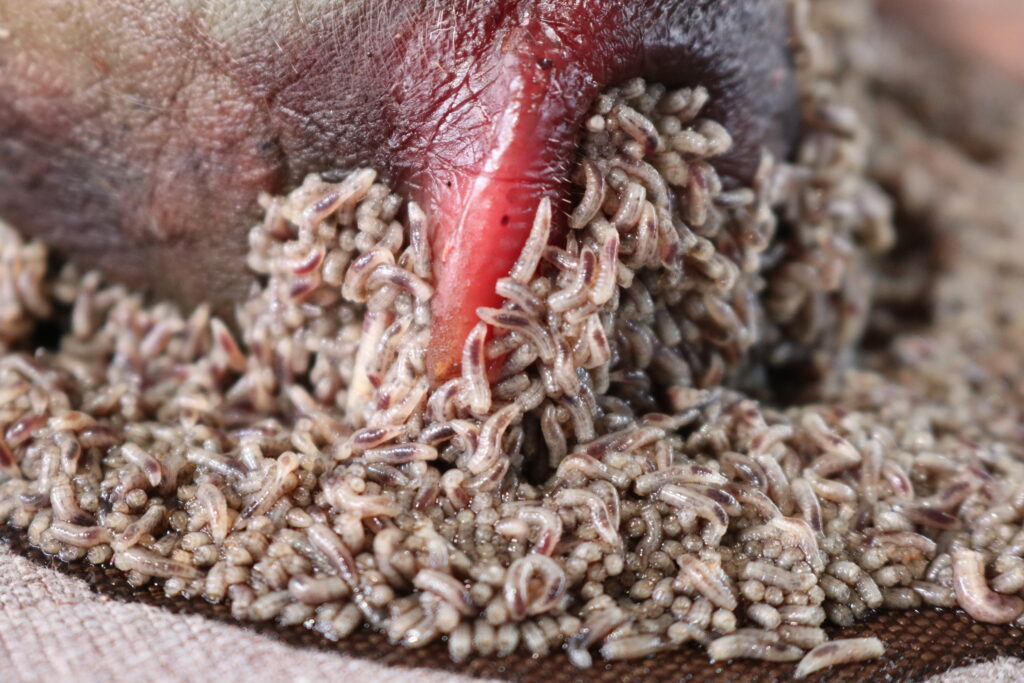
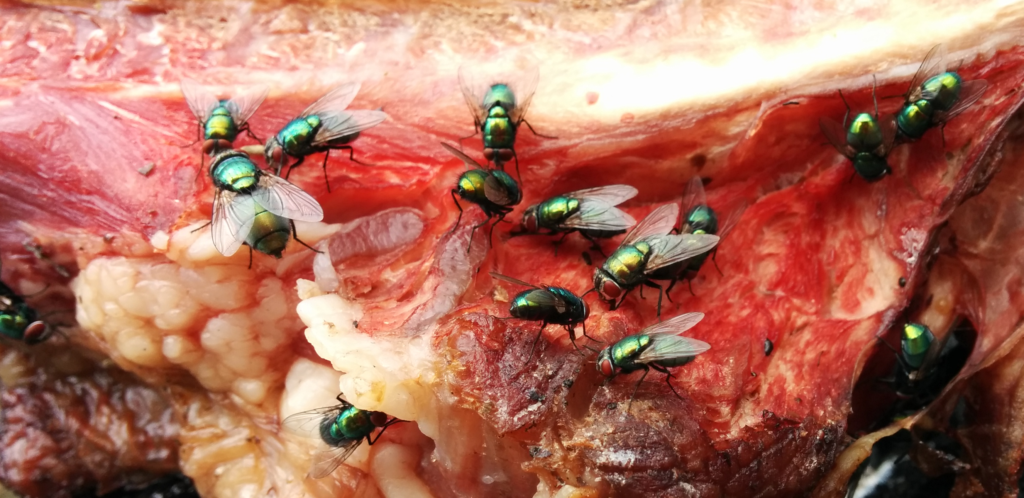
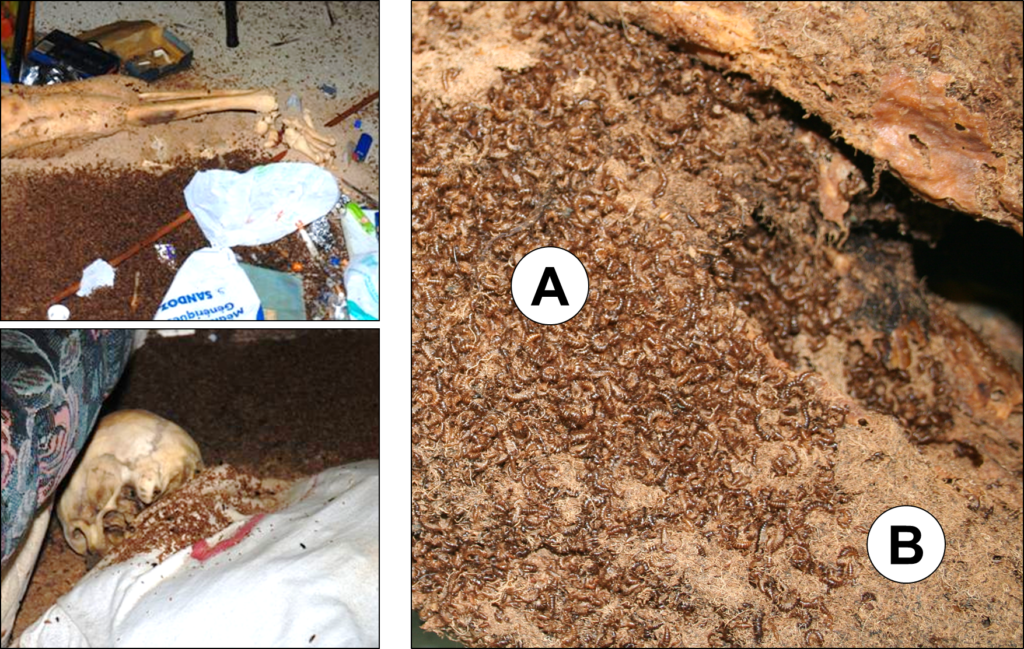
A: exuviae left by the larvae – B: fecal deposits © Damien CHARABIDZE
Estimating the age of larvae colonizing human remains
The fundamental principle of forensic entomology is to calculate the age of larvae or pupae in order to determine the timing of oviposition. Since necrophagous insects are involved, their presence indicates that the victim was already deceased at the time of colonization. For instance, if a body is discovered on May 28 and necrophagous insects aged 10 days are found on the remains, this means the victim had already been dead for 10 days prior to discovery, i.e., since May 18. This is referred to as the minimum postmortem interval.
To estimate larval age, it is necessary to identify the species and determine the temperature. The most widely used method is known as degree-days. To illustrate how it works, let us consider an example. Assume that the species collected from the body has a developmental threshold temperature, denoted Ts, of 10°C. This Ts value may be regarded as a fixed tax: only the degrees above this threshold contribute to larval development. At a constant temperature of 20°C, each day provides this species with 20°C – Ts = 10 degree-days for development. At 30°C, the larva accumulates 30 – Ts = 20 degree-days. The developmental target to reach is referred to as ADD (Accumulated Degree Days). In our example, let us suppose that 150 ADD are required for an egg of this species to reach the adult stage. At a constant temperature of 20°C, each day provides 10 degree-days, meaning that 15 days are needed to accumulate 150 ADD and obtain an adult fly. The same reasoning applies when temperature fluctuates: one day at 20°C followed by a day at 30°C provides 10 + 20 = 30 degree-days for the maggot.
This method has the advantage of being straightforward and applicable in both directions: one can observe a larva and determine when it will reach adulthood, or conversely start from the adult stage to reconstruct the duration of its larval development. This is precisely what is done in forensic investigations: the larvae found on the cadaver are identified, ambient temperatures are reconstructed, and from this the length of time the larvae have been developing on the remains is established, corresponding to the minimum postmortem interval.
How to estimate the colonization interval ?
Calculating the minimum postmortem interval is generally not sufficient. Returning to our previous example: in a case where a victim has been missing since December, stating that they had been dead for 10 days before the discovery of the body, i.e., since May 18, would not be of much practical use. The forensic entomologist’s task is therefore not only to determine the age of the larvae, but also to estimate the delay between death and the arrival of insects. When developing larvae of Calliphoridae flies are recovered, interpretation is relatively straightforward: under favorable conditions, these flies oviposit very shortly after death. The date of initial oviposition can thus be considered concomitant with the time of death.
By contrast, when colonization conditions are not optimal (adverse weather conditions, body located indoors) or in the case of so-called late-arriving species, it becomes more challenging, and sometimes impossible, to calculate the time elapsed between death and oviposition. In such situations, dating is therefore limited to establishing a minimum postmortem interval, sometimes supplemented with a qualitative estimate of the colonization delay.
Other contributions and limitations of forensic entomology
Beyond estimating the time of death, the study of the entomofauna associated with a corpse can shed light on events that occurred peri- or postmortem. The absence of a set of very common species on a body may indicate a temporary inaccessibility of the remains. This may result from confinement (e.g., sequestration of the body in a closed room), wrapping of the body, or unfavorable weather conditions. Conversely, it is often suggested that the presence of certain species could indicate the relocation of a body. This notion is largely unrealistic: the main necrophagous species are found throughout Central Europe and in almost all environments. It is therefore exceptional to encounter a species that serves as a specific geographic indicator. Two particular cases should nonetheless be mentioned: buried bodies, which are generally only minimally colonized, and submerged bodies, which are associated with a distinct fauna. Finally, necrophagous insects may sometimes colonize necrotic wounds in living individuals, a phenomenon referred to as myiasis. In such cases, larval analysis can provide information on the timing of the last medical care and help demonstrate potential neglect or abuse of a dependent person.
References :
- Amendt J, Campobasso CP, Gaudry E, Reiter C, LeBlanc HN, Hall M. 2007 Best practice in forensic entomology—standards and guidelines. International Journal of Legal Medicine 121, 90–104.
- Beauthier J-P. 2022 Traité de médecine légale et criminalistique. 3e édition. Louvain-la-Neuve: De Boeck Supérieur.
- Byrd JH, Tomberlin JK, editors. 2019 Forensic Entomology: The Utility of Arthropods in Legal Investigations. 3rd edn. Boca Raton: CRC Press.
- Charabidze D. 2021 Ils peuplent les morts: approche entomologique médico-légale. Lyon: Fage éditions.
- Charabidze D, Gosselin M, Collectif, Beauthier J-P. Insectes, Cadavres Scènes de Crime Principes et Applications de l’Entomologie Medico-Legale. Louvain-la-Neuve: De Boeck; 2014. 261 p.
- Erzinçlioglu Z. Blowflies. Slough: The Richmond Publishing Co. Ltd; 1996. (Naturalist’s Handbooks; vol. 23).
- Marchenko MI. Medicolegal relevance of cadaver entomofauna for the determination of the time of death. Forensic Science International. 15 août 2001;120(1–2):89‑109.
- Smith KGV. 1986 A manual of forensic entomology. London: Trustees of the British Museum (Natural history).
Tous droits réservés - © 2025 Forenseek










